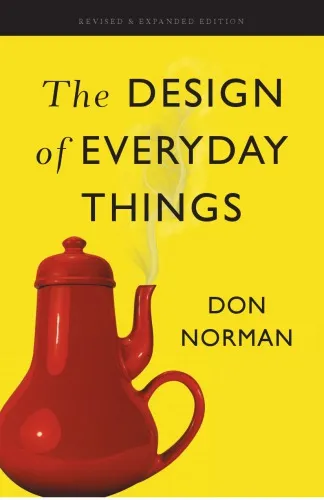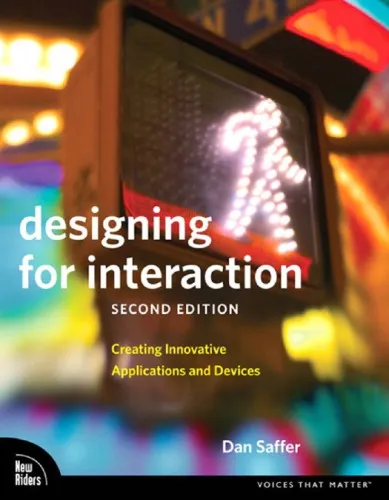The Design of Everyday Things - Revised and Expanded Edition
5.0
بر اساس نظر کاربران

شما میتونید سوالاتتون در باره کتاب رو از هوش مصنوعیش بعد از ورود بپرسید
هر دانلود یا پرسش از هوش مصنوعی 2 امتیاز لازم دارد، برای بدست آوردن امتیاز رایگان، به صفحه ی راهنمای امتیازات سر بزنید و یک سری کار ارزشمند انجام بدینکتاب های مرتبط:
Persian Summary
معرفی کتاب: طراحی چیزهای روزمره - ویرایش جدید و گسترشیافته
در دنیایی که طراحی نقش محوری در تجربه ما از اشیاء و تکنولوژی ایفا میکند، کتاب «طراحی چیزهای روزمره» نوشته دن نورمن، به عنوان یکی از منابع مهم و الهامبخش در حوزه طراحی شناخته میشود. این کتاب، دیدگاههای نوینی را درباره نحوه طراحی محصولات و تأثیر آن بر کاربران ارائه میدهد. در ادامه به بررسی فصلهای مختلف این کتاب و اهمیت آن میپردازیم.
خلاصهای جامع از کتاب
کتاب «طراحی چیزهای روزمره» به بررسی عمیق اصول اساسی طراحی تعامل میپردازد. دن نورمن در این کتاب با رویکردی عملی، مفاهیم مربوط به User-centered design را بررسی میکند و با مثالهای واقعی نشان میدهد که چگونه طراحی بد میتواند مانع استفاده صحیح و موثر کاربران از محصولات شود. او تاکید میکند که طراحی نه تنها باید زیبا بلکه باید قابل فهم باشد و به نیازهای اساسی کاربر پاسخ دهد.
نورمن توضیح میدهد که طراحی خوب باید درکشدنی و قابل استفاده باشد و ارتباط بین سیستم و کاربر را بهبود بخشد. او در مورد اهمیت فراهم کردن Feedback، affordances و signifiers در طراحی بحث میکند و نشان میدهد چگونه غفلت از این مفاهیم میتواند به طراحی ناموفق ختم شود.
نکات کلیدی
- Human-centered design: تاکید بر ضرورت تمرکز بر نیازها و محدودیتهای کاربران در فرایند طراحی.
- Visibility و Feedback: نقش حیاتی واضحبودن و ارائه بازخورد مناسب در استفاده کارآمد از محصولات.
- Constraints: استفاده صحیح از محدودیتها میتواند به سادهسازی طراحی و کاهش خطاها کمک کند.
- Mapping: ایجاد نگاشتهای واضح بین کنترلها و عملکردها برای ناوبری بهتر کاربر.
جملات معروف از کتاب
"When you have trouble with things—whether it’s figuring out whether to push or pull a door or the arbitrary vagaries of the modern computer and digital devices—it is not your fault. Don’t blame yourself: blame the designer."
"The problem with the designs of most products or systems is that they are focused around the requirements of business or engineering, rather than the needs of end users."
چرا این کتاب مهم است؟
«طراحی چیزهای روزمره» یک کتاب ضروری برای هر کسی است که به طراحی یا توسعه محصولات فکر میکند. این کتاب باعث میشود تا طراحان و توسعهدهندگان بیشتر به اهمیت تجربه کاربری و دیدگاههای انسانی در فرآیند طراحی توجه کنند. همچنین، این کتاب به روشنسازی ارتباط میان طراحی و عملکرد واقعی محصولات کمک میکند و نشان میدهد که چگونه طراحی موثر میتواند به بهبود زندگی افراد کمک کند. از این رو، این کتاب نه تنها برای طراحان بلکه برای مدیران محصول، مهندسان و هر کسی که در فرآیند تولید محصول قرار دارد، بسیار مفید است.
Welcome to the intriguing world of design, where the everyday intertwines with subtle artistry and intuitive functionality. "The Design of Everyday Things - Revised and Expanded Edition" by Don Norman unravels the intricacies behind the objects we interact with daily, infused with enhancements that reflect ongoing advancements in design thinking and user-centric solutions.
Summary of the Book
The revised edition of "The Design of Everyday Things" delves into the essential principles of design that facilitate seamless and intuitive experiences with objects. Norman introduces the reader to fundamental concepts such as discoverability, feedback, and the critical role of user-centered design. By examining common objects like doors and phones, the book unveils the often overlooked challenges in design that lead to user frustration and inefficiency.
With numerous examples and anecdotes, the author guides readers through the pitfalls of poor design while showcasing exemplary models that successfully integrate user needs. The text meticulously explores the relationship between design and usability, emphasizing the significance of affordances and signifiers in making products more accessible. This edition also integrates modern design challenges posed by technology, addressing issues in digital interfaces and the growing necessity for responsive design strategies.
Key Takeaways
- Understanding the vital role of human-centered design in creating intuitive and usable products.
- The importance of feedback loops and visibility in reducing errors and enhancing user satisfaction.
- The need to recognize constraints and affordances in fostering an intuitive connection between users and objects.
- Recognizing the iterative nature of the design process and the value of prototyping and testing.
- The impact of emotional responses on user interaction and the significance of designing for pleasure as well as functionality.
Famous Quotes from the Book
"It is not our fault. It is the fault of design." This statement encapsulates the philosophy that blames errors not on the user but on poorly designed systems.
"When you have trouble with things—whether it's figuring out whether to push or pull a door or the arbitrary vagaries of the modern computer and electronics industry—it’s not your fault." Norman insists that good design eliminates user faults.
Why This Book Matters
"The Design of Everyday Things" continues to be an essential read for both designers and those intrigued by the mechanics of daily interaction with objects. In this revised edition, Norman responds to the dynamic landscape of design, emphasizing the need for adaptable, human-centered approaches. As technology rapidly advances, the principles outlined in the book remain a cornerstone for industries striving to harmonize functionality with user experience.
The insights provided have permeated beyond design into areas such as marketing and psychological user analysis, reflecting the broad influence of Norman's work. This book challenges professionals to rethink how interfaces and products are crafted, advocating for a world where everyday things are not just tools but partners in daily life.
دانلود رایگان مستقیم
شما میتونید سوالاتتون در باره کتاب رو از هوش مصنوعیش بعد از ورود بپرسید
دسترسی به کتابها از طریق پلتفرمهای قانونی و کتابخانههای عمومی نه تنها از حقوق نویسندگان و ناشران حمایت میکند، بلکه به پایداری فرهنگ کتابخوانی نیز کمک میرساند. پیش از دانلود، لحظهای به بررسی این گزینهها فکر کنید.
این کتاب رو در پلتفرم های دیگه ببینید
WorldCat به شما کمک میکنه تا کتاب ها رو در کتابخانه های سراسر دنیا پیدا کنید
امتیازها، نظرات تخصصی و صحبت ها درباره کتاب را در Goodreads ببینید
کتابهای کمیاب یا دست دوم را در AbeBooks پیدا کنید و بخرید
1748
بازدید5.0
امتیاز1
نظر98%
رضایتنظرات:
5.0
بر اساس 1 نظر کاربران
moji
23 اکتبر 2024، ساعت 14:16
این کتاب یکی از اساسی ترین کتاب ها در زمینه تجربه کاربری هست که ابتدایی ترین (ممکنه به نظر ساده برسند ولی خیلی خیلی مهم هستند) اصول رو به شما آموزش میده و به شما برای درک و آشنایی بهتر با ضعف های طراحی مهندسی و نحوه برقراری ارتباط مابین کاربر و محصول کمک میکنه. اگر ترجمه های فارسی این کتابو خوندید و راضی کننده نبوده حتما نسخه انگلیسیشو بخونید چون بعضی جاها انتقال مفهوم جملات توی ترجمه ها واقعا ضعیف بودند
Questions & Answers
Ask questions about this book or help others by answering
No questions yet. Be the first to ask!










